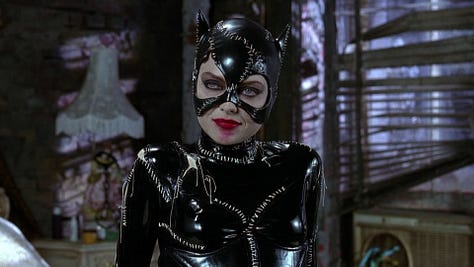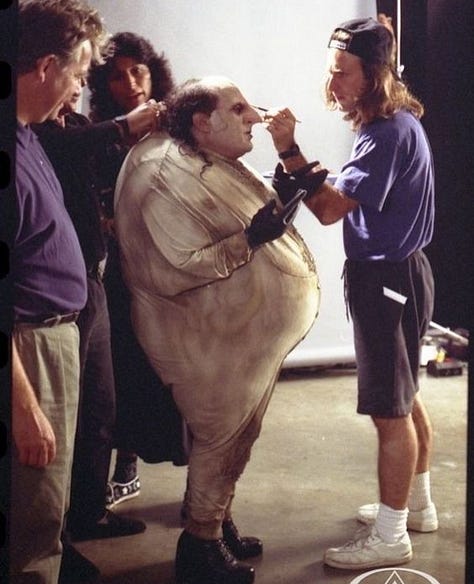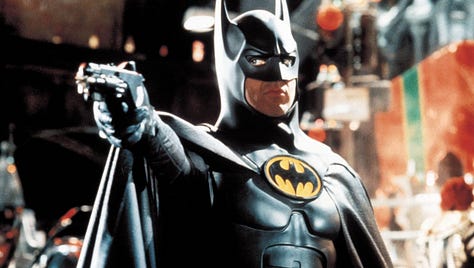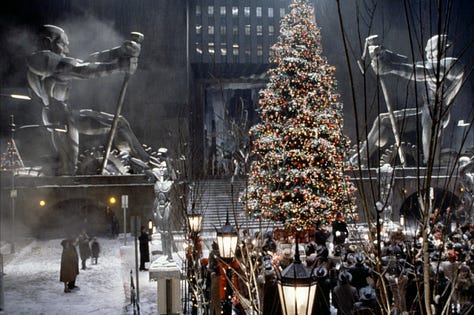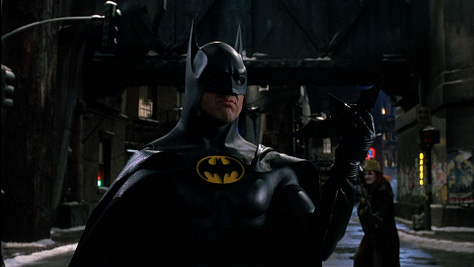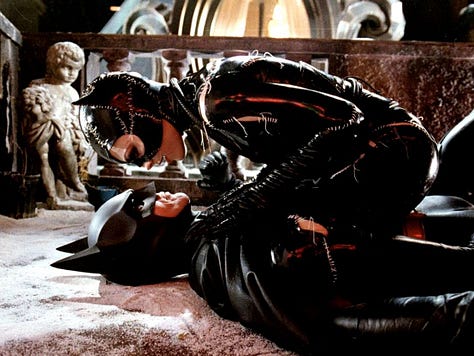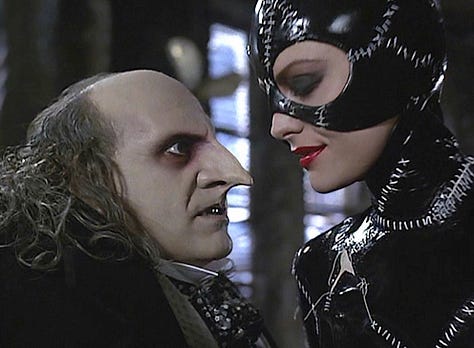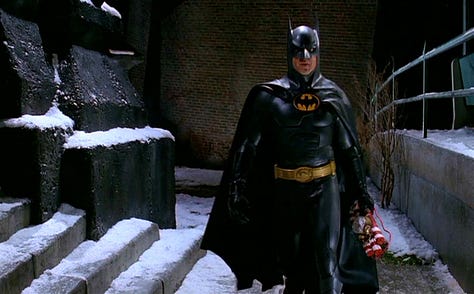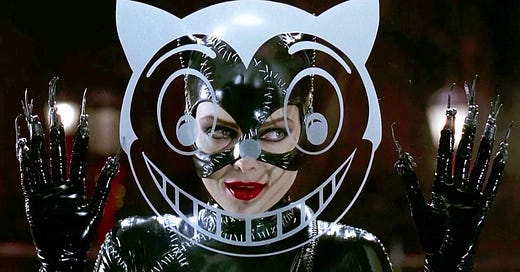BATMAN RETURNS
1992 • Tim BurtonCast: Michael Keaton, Danny DeVito, Michelle Pfeiffer, Christopher Walken, Michael Gough, Pat Hingle, Michael Murphy, Andrew Bryniarski, Cristi Conaway, Paul Reubens
Screenplay: Daniel Waters; Story by Daniel Waters, Sam Hamm; Based on Batman characters created by Bob Kane & Bill Finger and published by DC Comics
Cinematography: Stefan Czapsky
Music: Danny Elfman
Producer: Denise Di Novi, Tim Burton
Warner Bros.
A kiss under the mistletoe. You know, mistletoe can be deadly if you eat it.
But a kiss can be even deadlier… if you mean it.
It’s Christmastime in Gotham City and Batman continues to protect its citizens in the second installment of the Tim Burton Batman franchise. This time Batman has to deal with a double threat. First, The Penguin, a hideous circus freak that has managed to gain the popularity needed to run for mayor of Gotham City. Adding to Batman’s troubles is the sexy but dangerous Catwoman, who is out for revenge on the man who tried to have her killed. What on the surface is standard superhero fare, is in actuality probably the most subversive comic book film of all time. The film takes a darker and more unconventional approach to the superhero genre, challenging traditional expectations and delving into the psychological complexities of its characters.
The direct sequel to the 1989 box office mega success, Batman Returns takes a decidedly darker turn. At first glance, Batman Returns seems to adhere to the standard formula of a superhero film, featuring the famous masked vigilante, diabolical villains, and larger-than-life action sequences. However, beneath this familiar exterior lies a narrative that subverts expectations. One of the key elements that contribute to the film's subversive nature is its exploration of the psychological struggles and traumas of its characters. Unlike many superhero films, Batman Returns places a heavy emphasis on the psychological aspects of its characters, particularly Batman/Bruce Wayne (Michael Keaton), Catwoman/Selina Kyle (Michelle Pfeiffer), and the Penguin/Oswald Cobblepot (Danny DeVito). Each character is portrayed with a depth that goes beyond the typical hero and villain archetypes, delving into their inner conflicts, desires, and vulnerabilities. Batman, instead of being an infallible hero, grapples with his own internal demons and moral dilemmas. Catwoman is reimagined as a complex and sympathetic character struggling with her own fractured identity. The Penguin, far from a one-dimensional villain, has a tragic origin story, rejected by his parents and society.
Tim Burton's signature dark and gothic aesthetic permeates the entire film, even more so than his original 1989 entry, creating a world that feels more like a twisted fairy tale than a typical comic book adaptation. The fantastical elements are underscored by the film's exploration of alienation, corruption, and the consequences of unchecked capitalism. This blend of fantasy and social commentary sets Batman Returns apart from its predecessor, while also delivering a thrilling, and at times, campy action movie.
Warner Bros. was reportedly displeased with the darker and more subversive direction taken by Tim Burton. The film's tone and content were considered too mature for a traditional superhero audience, and the marketing team faced the challenge of promoting a movie that did not conform to the more family-friendly expectations associated with comic book adaptations. After all, they had toys, Diet Coke tie-ins and Happy Meals to sell. While Batman Returns performed well at the box office, Warner Bros. likely anticipated a more conventional and commercially viable sequel, leading to creative differences between Burton and the studio. This likely led to Burton’s ousting as director for Batman Forever, ultimately being replaced by Joel Schumacher for the third, more marketing-friendly, installment.
Most of the cast/characters return. Gone are Vicki Vale and Harvey Dent. Replacing Vale as the love interest is Michelle Pfeiffer’s Selina Kyle/Catwoman, also pulling double duty as one of the film’s two top-billed villains. The other heavy is Danny DeVito as The Penguin. The two baddies team up to destroy the Dark Knight. Joining the cast is the delightfully sinister Christopher Walken as the ultra-capitalist Max Schrek, his name likely an homage to the German actor who stalked the screens in 1922’s Nosferatu.
What frustrates a lot of hardcore comic book fans about this film is the change to the backstories of the characters. Selina Kyle in the comics is a cat burglar. In this film, she is the bumbling secretary of the shady Max Shreck. After stumbling onto something she shouldn’t have, Max shoves her out of the window of a high-rise office building. Selina is then resurrected and seemingly possessed by a swarm of alley cats and she is reborn as Catwoman. While this is indeed a drastic departure from the comics, it is nonetheless meaningless when compared to Pfeiffer’s fantastic performance. Her Catwoman is one of the best, and sexiest, portrayals of the character on screen. She oozes sexuality, sin, and danger… everything that the character is supposed to represent.
The four-color version of The Penguin is that of a sophisticated mob boss dressed in tuxedoes. Batman Returns turned him into a much darker character. Abandoned at birth by his parents after he was born a deformed freak, he was raised in the Gotham sewers and grew up in the world as a sideshow performer. He has revenge on his mind to kill all of Gotham’s children, when he gets sidetracked into sabotaging Batman’s reputation and running for Mayor. DeVito hams it up as The Penguin, but he never goes too far. Instead of mimicking Jack Nicholson (unlike Tommy Lee Jones a few years later), he took the character in its own twisted direction.
Keaton is back as the Caped Crusader for what would prove to be his last run at the character until 2023’s The Flash. (Well, he had returned for Batgirl, but that movie was discarded by Warner Bros.) While many might disagree, I would argue that Keaton turns in a better performance here than he did in 1989. By this point, he effortlessly embodies the superhero's mannerisms, his voice resonating with a seasoned gravitas. Keaton not only captures the external facets of Batman but also delves deeper into the character's psyche, portraying the Caped Crusader with a richer understanding of his inner conflicts and moral complexities. Keaton's portrayal benefits from the cumulative effect of his earlier experience in the role. In Batman Returns, the actor seamlessly channels the brooding intensity of Bruce Wayne (his first appearance in the film is perfect), portraying a hero whose internal struggles are as pronounced as his external battles. The evolution of Keaton's performance from the first film to the sequel is evident, showcasing a Batman who is not only physically imposing but emotionally resonant.
I’m a big fan of the film’s look. The entire film is blanketed in darkness, contrast against a Christmastime setting. You have three incredibly dark characters (in both look and tone) set against the background of holiday cheer and freshly falling snow. Against the canvas of the holiday season, a time traditionally associated with warmth and joy, Burton sets the stage for a story that subverts expectations, creating an atmosphere where the boundaries between good and evil blur. The visual dichotomy is accentuated by the presence of three remarkably dark characters, both in appearance and tone—Batman, Catwoman, and the Penguin. These figures, shrouded in mystery and driven by their own inner demons, stand out starkly against the cheery veneer of holiday decorations and freshly falling snow. Christmas is associated with family and warmth, yet the three main characters (Batman, Catwoman and Penguin) are decidedly very lonely. Each yearns for companionship while struggling with their own identities in the season of goodwill.
Danny Elfman’s score adds to it, mixing the original Batman theme music with just a tinge of holiday sound. Elfman, who also composed the score for the 1989 Batman, demonstrates his musical prowess by seamlessly blending the original Batman theme with a subtle infusion of holiday sounds. The familiar sound of the Batman theme, with its orchestral grandeur, provides continuity that harkens back to the first installment, yet, Elfman deftly introduces a nuanced twist by incorporating just a hint of holiday elements into the composition. The result mirrors the film's visual contrasts, combining the dark, brooding tones of Gotham with the festive spirit of Christmas.
The (Oscar-nominated) makeup, created by the master Stan Wiston, is particularly well done, especially the transformation of Danny DeVito into the grotesque yet tragically compelling Penguin. Danny DeVito's portrayal of the Penguin is a tour de force, and much of the character's impact is owed to the exceptional makeup work. The prosthetics, facial enhancements, and detailed costume design collectively contribute to the Penguin's grotesque appearance, creating a character who embodies the physical toll of a life spent in the grimy depths of Gotham's sewers. The makeup team's meticulous attention to detail is evident in every grotesque feature, from the elongated nose to the pallid, almost corpse-like complexion. The makeup doesn't merely serve as a cosmetic enhancement but becomes an integral part of the character and enhances DeVito’s performance.
Michelle Pfeiffer's Catwoman is not only iconic for her performance but also for her costume design. The decision to reimagine Catwoman's attire as a leather one-piece that appears to be stitched together by a madwoman is a visually arresting departure from both comic book interpretations and previous television adaptations. In the comic books and the TV show, Catwoman's costume often leaned towards a more sleek and polished aesthetic, emphasizing her feline agility and alluring charm. However, in "Batman Returns," the costume takes on a raw, DIY quality that aligns perfectly with Tim Burton's dark and unconventional vision for the film. The leather one-piece, with its jagged stitching and haphazard design, becomes a visual representation of Selina Kyle's fractured psyche and her transformation into Catwoman. As the film progresses, the stitching slowly starts to unravel, literally at the seams, just like Selina’s grip on reality starts to rip apart. Michelle Pfeiffer's dynamic performance elevates Catwoman into a character that transcends her comic book origin.
In recent years, Batman Returns has found resonance within the queer community, particularly in its portrayal of Catwoman and, to a lesser extent, the Penguin. The film's enduring appeal among queer audiences lies in its subversive themes, unconventional characters, and nuanced performances that challenge traditional societal norms. Catwoman's journey from Selina Kyle, a repressed and mistreated woman, to the fierce and empowered antihero resonates with themes of self-discovery and liberation. The fluidity of her character's identity and the rejection of societal expectations align with the queer experience, contributing to her popularity among queer audiences. The adoption of Catwoman by the queer community is also influenced by the character's rejection of a binary understanding of good and evil. Catwoman occupies a morally gray area, challenging the traditional dichotomies prevalent in superhero narratives. This complexity allows for diverse interpretations and identification. The Penguin has also garnered some attention, albeit to a lesser extent. The Penguin's outsider status and his tragic narrative resonate with themes of marginalization and societal rejection. While not as prominent as Catwoman, probably because his character is more inherently “evil”, the Penguin's character offers an exploration of otherness and the struggle for acceptance. This is in contrast to Batman himself, who, while he struggles with his own identity, longs to return everything to the status quo. When he offers this to Selina in the film’s climax, she violently rejects it. Queer audiences often appreciate narratives that challenge normative expectations and offer diverse representations. (As a matter of full disclosure, I am not part of the queer community, so hopefully I have not misrepresented their adoption of this film.)
Batman Returns stands as a subversive masterpiece within the superhero genre, challenging conventions and pushing the boundaries of what a comic book film can be. Its exploration of complex characters, psychological depth, and socio-political themes sets it apart from its peers. While Warner Bros. may not have been entirely pleased with the outcome, the film has endured as a testament to the creative risks that can be taken within the realm of superhero storytelling.
It's the so-called "normal" guys who always let you down. Sickos never scare me. Least they're committed.
Notable Awards & Accomplishments
Academy Award Nominee: Best Visual Effects
Academy Award Nominee: Best Make-Up
Saturn Award Nominee: Best Fantasy Film
Streaming: MAX, Tubi
Digital Rental/Purchase: Available at most major digital retailers
Physical Media: Available on 4K, Blu-Ray and DVD
